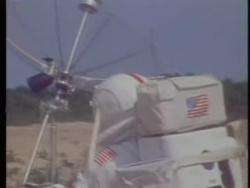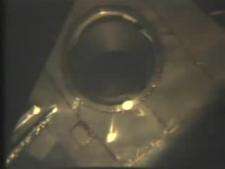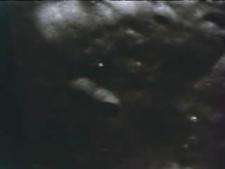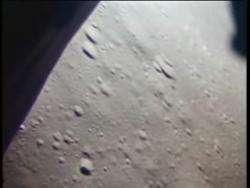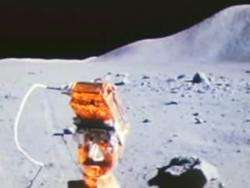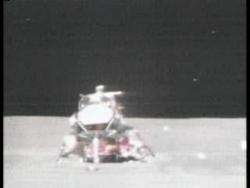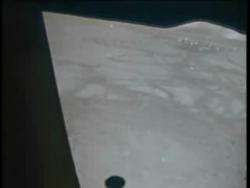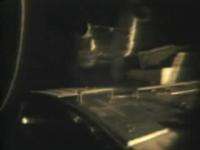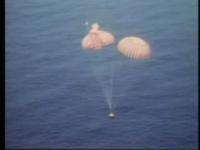Apollo 15
 Jim Irwin with the Lunar Roving Vehicle on the first lunar surface EVA of Apollo 15 | |||||
| Mission type | Manned lunar landing | ||||
|---|---|---|---|---|---|
| Operator | NASA[1] | ||||
| COSPAR ID |
| ||||
| SATCAT № |
| ||||
| Mission duration | 12 days, 7 hours, 11 minutes, 53 seconds | ||||
| Spacecraft properties | |||||
| Spacecraft |
| ||||
| Manufacturer |
| ||||
| Launch mass | 48,599 kilograms (107,142 lb) | ||||
| Landing mass | 5,321 kilograms (11,731 lb) | ||||
| Crew | |||||
| Crew size | 3 | ||||
| Members | |||||
| Callsign |
| ||||
| EVAs |
1 in cislunar space | ||||
| EVA duration |
39 minutes, 7 seconds | ||||
| Start of mission | |||||
| Launch date | July 26, 1971, 13:34:00.6 UTC | ||||
| Rocket | Saturn V SA-510 | ||||
| Launch site | Kennedy LC-39A | ||||
| End of mission | |||||
| Recovered by | USS Okinawa | ||||
| Landing date | August 7, 1971, 20:45:53 UTC | ||||
| Landing site |
North Pacific Ocean 26°7′N 158°8′W / 26.117°N 158.133°W | ||||
| Orbital parameters | |||||
| Reference system | Selenocentric | ||||
| Periselene | 101.5 kilometers (54.8 nmi) | ||||
| Aposelene | 120.8 kilometers (65.2 nmi) | ||||
| Inclination | 23 degrees | ||||
| Epoch | July 30, 1971 | ||||
| Lunar orbiter | |||||
| Spacecraft component | Command/Service Module | ||||
| Orbital insertion | July 29, 1971, 20:05:46 UTC | ||||
| Departed orbit | August 4, 1971, 21:22:45 UTC | ||||
| Orbits | 74 | ||||
| Lunar lander | |||||
| Spacecraft component | Lunar Module | ||||
| Landing date | July 30, 1971, 22:16:29 UTC | ||||
| Return launch | August 2, 1971, 17:11:23 UTC | ||||
| Landing site |
Hadley–Apennine 26°07′56″N 3°38′02″E / 26.13222°N 3.63386°E | ||||
| Sample mass | 77 kilograms (170 lb) | ||||
| Surface EVAs | 4 (including standup) | ||||
| EVA duration |
| ||||
| Lunar rover | |||||
| Distance covered | 27.9 kilometers (17.3 mi) | ||||
| Docking with LM | |||||
| Docking date | July 26, 1971, 17:07:49 UTC | ||||
| Undocking date | July 30, 1971, 18:13:16 UTC | ||||
| Docking with LM Ascent Stage | |||||
| Docking date | August 2, 1971, 19:10:25 UTC | ||||
| Undocking date | August 3, 1971, 01:04:01 UTC | ||||
| Payload | |||||
| Mass |
| ||||
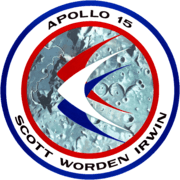  Left to right: Scott, Worden, Irwin
| |||||
Apollo 15 was the ninth manned mission in the United States' Apollo program, the fourth to land on the Moon, and the eighth successful manned mission. It was the first of what were termed "J missions", long stays on the Moon, with a greater focus on science than had been possible on previous missions. It was also the first mission on which the Lunar Roving Vehicle was used.
The mission began on July 26, 1971, and ended on August 7. At the time, NASA called it the most successful manned flight ever achieved.[2]
Commander David Scott and Lunar Module Pilot James Irwin spent three days on the Moon, including 18½ hours outside the spacecraft on lunar extra-vehicular activity (EVA). The mission landed near Hadley rille, in an area of the Mare Imbrium called Palus Putredinus (Marsh of Decay). The crew explored the area using the first lunar rover, which allowed them to travel much farther from the Lunar Module (LM) than had been possible on missions without the rover. They collected 77 kilograms (170 lb) of lunar surface material. At the same time, Command Module Pilot Alfred Worden orbited the Moon, using a Scientific Instrument Module (SIM) in the Service Module (SM) to study the lunar surface and environment in great detail with a panoramic camera, a gamma-ray spectrometer, a mapping camera, a laser altimeter, a mass spectrometer, and a lunar sub-satellite deployed at the end of Apollo 15's stay in lunar orbit (an Apollo program first).
The mission successfully accomplished its objectives, but was marred by negative publicity that accompanied disclosure of the crew carrying unauthorized postage stamps which they had planned to sell after their return. Ironically, this mission was one of very few that had been honored with the issue of a commemorative US stamp, with this first use of a lunar rover happening one decade after the first Mercury astronaut launch.
Crew
| Position | Astronaut | |
|---|---|---|
| Commander | David R. Scott Third and last spaceflight | |
| Command Module Pilot | Alfred M. Worden Only spaceflight | |
| Lunar Module Pilot | James B. Irwin Only spaceflight | |
All three astronauts on the all-United States Air Force crew received an honorary degree or master's degree from the University of Michigan, including Scott's honorary degree, awarded in the spring of 1971, months before the launch. Scott had attended the University of Michigan, but left before graduating to accept an appointment to the United States Military Academy. The crewmen did their undergraduate work at either the United States Military Academy or the United States Naval Academy.
Backup crew
| Position | Astronaut | |
|---|---|---|
| Commander | Richard F. Gordon, Jr. | |
| Command Module Pilot | Vance D. Brand | |
| Lunar Module Pilot | Harrison H. Schmitt | |
Schmitt was the first member of Group 4 to be selected as a prime or backup crew member for an Apollo flight; from Group 4 he was the only astronaut to make it to the Moon, with the last Apollo mission at the end of 1972.
Support crew
Flight directors
- Gerry Griffin, Gold team
- Milton Windler, Maroon team
- Glynn Lunney, Black team
- Gene Kranz, White team
Mission parameters
- Mass:
- Launch mass: 2,945,816 kg
- Total spacecraft: 46,782 kg
- CSM mass: 30,354 kg, of which CM was 5840 kg, SM 24,523 kg
- LM mass: 16,428 kg, ascent stage at lunar liftoff 4,951 kg
- Earth orbits: 3 before leaving for Moon
- Lunar orbits: 74
Earth parking orbit
- Perigee: 169.5 km
- Apogee: 171.3 km
- Inclination: 29.679°
- Period: 87.84 min
LM-CSM docking
- Undocked: July 30, 1971 - 18:13:16 UTC
- Docked: August 2, 1971 - 19:10:25 UTC
EVAs
- Scott - Stand up EVA - LM upper hatch
- Start Stand Up EVA: July 31, 1971, 00:16:49 UTC
- End Stand Up EVA: July 31, 00:49:56 UTC
- Duration: 33 minutes, 07 seconds
- Scott and Irwin - EVA 1
- EVA 1 Start: July 31, 1971, 13:12:17 UTC
- EVA 1 End: July 31, 19:45:59 UTC
- Duration: 6 hours, 32 minutes, 42 seconds
- Scott and Irwin - EVA 2
- EVA 2 Start: August 1, 1971, 11:48:48 UTC
- EVA 2 End: August 1, 19:01:02 UTC
- Duration: 7 hours, 12 minutes, 14 seconds
- Scott and Irwin - EVA 3
- EVA 3 Start: August 2, 1971, 08:52:14 UTC
- EVA 3 End: August 2, 13:42:04 UTC
- Duration: 4 hours, 49 minutes, 50 seconds
- Worden (Irwin - Stand up) - Transearth EVA 4
- EVA 4 Start: August 5, 1971, 15:31:12 UTC
- EVA 4 End: August 5, 16:10:19 UTC
- Duration: 39 minutes, 07 seconds
Planning and training

The crew for Apollo 15 had previously served as the backup crew for Apollo 12. There had been a friendly rivalry between that prime and backup crew on that mission, with the prime being all United States Navy, and the backup all United States Air Force.
Originally Apollo 15 would have been an H mission, like Apollos 12, 13 and 14. But on September 2, 1970, NASA announced it was canceling what were to be the current incarnations of the Apollo 15 and Apollo 19 missions. To maximize the return from the remaining missions, Apollo 15 would now fly as a J mission and have the honor of carrying the first lunar rover.
One of the major changes in the training for Apollo 15 was the geology training. Although on previous flights the crews had been trained in field geology, for the first time Apollo 15 would make it a high priority. Scott and Irwin would train with Leon Silver, a Caltech geologist who on Earth was interested in the Precambrian. Silver had been suggested by Harrison Schmitt as an alternative to the classroom lecturers that NASA had previously used. Among other things, Silver had made important refinements to the methods for dating rocks using the decay of uranium into lead in the late 1950s.
At first Silver would take the prime and backup crews to various geological sites in Arizona and New Mexico as if for a normal field geology lesson, but as launch time approached, these trips became more realistic. Crews began to wear mock-ups of the backpacks they would carry, and communicate using walkie-talkies to a CAPCOM in a tent. (During a mission the Capsule Communicators (CAPCOMs), always fellow astronauts, were the only people who normally would speak to the crew.) The CAPCOM was accompanied by a group of geologists unfamiliar with the area who would rely on the astronauts' descriptions to interpret the findings.
The decision to land at Hadley came in September 1970. The Site Selection Committees had narrowed the field down to two sites — Hadley Rille or the crater Marius, near which were a group of low, possibly volcanic, domes. Although not ultimately his decision, the commander of a mission always held great sway. To David Scott the choice was clear, with Hadley, being "exploration at its finest."
Command Module Pilot Alfred Worden undertook a different kind of geology training. Working with an Egyptian-born geologist, Farouk El-Baz, he flew over areas in an airplane simulating the speed at which terrain would pass below him while in the Apollo Command/Service Module (CSM) in orbit. He became quite adept at making geologic observations as objects passed below.
Mission highlights
Launch and outbound trip
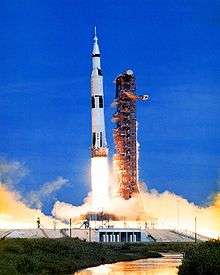
Apollo 15 was launched on July 26, 1971, at 9:34 AM EDT from the Kennedy Space Center at Merritt Island, Florida. During the launch, the S-IC did not completely shut off following staging for four seconds, creating the possibility of the spent stage banging into the S-II engines, damaging them and forcing an abort (the S-II exhaust also struck a telemetry package on the S-IC and caused it to fail). Despite this, the third stage and spacecraft reached its planned Earth parking orbit. A couple of hours into the mission, the third stage reignited to propel the spacecraft out of Earth orbit and on to the Moon.[3]
A few days after launching from Florida, the spacecraft passed behind the far side of the Moon, where the Service Propulsion System (SPS) engine on the CSM ignited for a six-minute burn, to slow the craft down into an initial lunar orbit. Once the lowest point of altitude in the orbit was reached, the SPS engine was fired again, to place the spacecraft into the proper descent orbit for the Lunar Module landing at Hadley.[3]
Moon landing
Most of the first part of the day after arriving in lunar orbit on July 30 was spent in preparing the Lunar Module for descent to the lunar surface later on that day. When preparations were complete, un-docking from the CSM was attempted; it did not occur, because of a faulty seal in the hatch mechanism. The Command Module Pilot, Alfred Worden, re-sealed the hatch; the LM then separated from the CSM. David Scott and James Irwin continued preparations for the descent while Worden remained in the CSM, returning to a higher orbit to perform lunar observations and await his crewmates' return a few days later.[4][ALSJ 1]
Soon, Scott and Irwin began the descent to the Hadley landing site. Several minutes after descent was initiated, at pitch-over and the beginning of the approach phase of the landing, the LM was six kilometers east of the pre-selected landing target. On learning this, Scott altered the flight path of the LM. They touched down at 22:16:29 UTC on July 30 at Hadley, within a few hundred meters of the planned landing site. One of the legs of the LM landed in a small crater so the module was tilted by 10° – the maximum acceptable was 15°. While previous crews had exited the Lunar Module shortly after landing, the crew of Apollo 15 elected to spend the rest of the day inside the LM, waiting until the next day to perform the first of three EVAs, or moonwalks, in order to preserve their sleep rhythm on a mission on which they were to spend a significantly longer time on the surface than previous crews had spent. Before they slept, Scott performed a stand-up EVA, during which the LM was depressurized and he photographed their surroundings from the top docking hatch.[4][ALSJ 1][ALSJ 2][5]
Lunar surface

Throughout the sleep period, Mission Control, in Houston, monitored a slow but steady oxygen leak. The data output of the onboard telemetry computers was limited during the night to conserve energy, so controllers could not determine the exact cause of the leak without awaking the crew. Scott and Irwin eventually were awakened an hour early, and the source of the leak was found to be an open valve on the urine transfer device. After the problem was solved, the crew began preparation for the first Moon walk.[ALSJ 3]
Four hours later, Scott and Irwin became the seventh and eighth humans, respectively, to walk on the Moon. After unloading the Lunar Roving Vehicle (LRV), the two drove to the first moonwalk's primary destination, Elbow Crater, along the edge of Hadley Rille. On returning to the LM Falcon, Scott and Irwin deployed the Apollo Lunar Surface Experiments Package (ALSEP). The first EVA lasted about 6½ hours.[4][ALSJ 4]
The target of the second EVA, the next day, was the edge of Mount Hadley Delta, where the pair sampled boulders and craters along the Apennine Front. During this moonwalk, the astronauts recovered what came to be one of the more famous lunar samples collected on the Moon during Apollo, sample #15415, more commonly known as the "Genesis Rock." Once back at the landing site, Scott continued to try to drill holes for an experiment at the ALSEP site, with which he had struggled the day before. After conducting soil-mechanics experiments and erecting a U.S. flag, Scott and Irwin returned to the LM. EVA 2 lasted 7 hours and 12 minutes.[4][ALSJ 4]
During EVA 3, the third and final moonwalk of the mission, the crew again ventured to the edge of Hadley Rille, this time to the northwest of the immediate landing site. After returning to the LM's location, Scott performed an experiment in view of the television camera, using a feather and hammer to demonstrate Galileo's theory that all objects in a given gravity field fall at the same rate, regardless of mass (in the absence of aerodynamic drag). He dropped the hammer and feather at the same time; because of the negligible lunar atmosphere, there was no drag on the feather, which hit the ground at the same time as the hammer.
Scott then drove the rover to a position away from the LM, where the television camera could be used to observe the lunar liftoff. Before the mission, the crew had contacted Belgian sculptor Paul Van Hoeydonck to create a small aluminum statuette called "Fallen Astronaut" to commemorate those astronauts and cosmonauts who lost their lives in the pursuit of space exploration. Scott left the sculpture by the rover, along with a plaque bearing the names of 14 American astronauts and Soviet cosmonauts who were known up to that time.[6][7] The memorial was left while the television camera was turned off; only Irwin knew what Scott was doing at the time. Scott told mission control he was doing some cleanup activities around the rover.
The EVA lasted 4 hours and 50 minutes.[4][ALSJ 4] In total, the two astronauts spent 18½ hours outside the LM and collected approximately 77 kg (170 lb) of lunar samples.[ALSJ 4]
Return to Earth
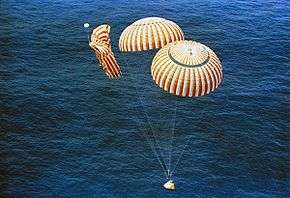
After lifting off from the lunar surface 2 days and 18 hours after landing, the LM ascent stage rendezvoused and re-docked with the CSM with Worden aboard in orbit. After transferring samples and other items from the LM to the CSM, the LM was sealed off, jettisoned, and intentionally crashed into the lunar surface. After completing more observations of the Moon from orbit and releasing the sub-satellite, the three-person crew departed lunar orbit with another burn of the SPS engine.[3]
The next day, on the return trip to Earth, Worden performed a spacewalk in deep space, the first of its kind, to retrieve exposed film from the SIM bay. Later on in the day, the crew set a record for the longest Apollo flight to that point.[8]
On approach to Earth the next day, August 7, the Service Module was jettisoned, and the Command Module (CM) reentered the Earth's atmosphere. Although one of the three parachutes on the CM failed to deploy properly, only two were required for a safe landing (one extra for redundancy). Upon landing in the North Pacific Ocean, the crew were recovered and taken aboard the recovery ship, USS Okinawa after a mission lasting 12 days, 7 hours, 11 minutes, and 53 seconds.[3][4]
Hardware
Spacecraft

Apollo 15 used Command/Service Module CSM-112, which was given the call sign Endeavour, named after the HMS Endeavour and Lunar Module LM-10, call sign Falcon, named after the United States Air Force Academy mascot. If Apollo 15 had flown as an H mission, it would have been with CSM-111 and LM-9. That CSM was used by the Apollo–Soyuz Test Project in 1975, but the Lunar Module went unused and is now on display at the Kennedy Space Center Visitor Complex.
After re-entry, one of Endeavour's three main parachutes collapsed after opening. Only two of the three parachutes were required for safe splashdown; the third was a contingency. Endeavour ultimately splashed down safely to end the mission.
Technicians at the Kennedy Space Center had many problems with the SIM bay in the Service Module. It was the first time it had flown and experienced problems from the start. Problems came from the fact the instruments were designed to operate in zero gravity, but had to be tested in the 1 g on the surface of the Earth. As such, things like the 7.5 m booms for the mass and gamma ray spectrometers could only be tested using railings that tried to mimic the space environment, and so they never worked particularly well. When the technicians tried to integrate the entire bay into the rest of the spacecraft, data streams would not synchronize, and lead investigators of the instruments would want to make last minute checks and changes. When it came time to test the operation of the gamma-ray spectrometer, it was necessary to stop every engine within 10 miles (16 km) of the test site.
On the Lunar Module, the fuel and oxidizer tanks were enlarged on both the descent and ascent stages and the engine bell on the descent stage was extended. Batteries and solar cells were added for increased electrical power. In all this increased the weight of the Lunar Module to 36,000 pounds (16,000 kilograms), 4,000 pounds (1,800 kg) heavier than previous models.
Endeavour is currently on display at the National Museum of the United States Air Force at Wright-Patterson Air Force Base in Dayton, Ohio.
Lunar Rover
The Lunar Roving Vehicle had been in development since May 1969, with the contract awarded to Boeing. It could be folded into a space 5 ft by 20 in (1.5 m by 0.5 m). Unloaded it weighed 460 lb (209 kg) and when carrying two astronauts and their equipment, 1500 lb (700 kg). Each wheel was independently driven by a ¼ horsepower (200 W) electric motor. Although it could be driven by either astronaut, the Commander always drove. Travelling at speeds up to 6 to 8 mph (10 to 12 km/h), it meant that for the first time the astronauts could travel far afield from their lander and still have enough time to do some scientific experiments.[9]
Lunar subsatellite

The Apollo 15 subsatellite (PFS-1) was a small satellite released into lunar orbit from the SIM bay. Its main objectives were to study the plasma, particle, and magnetic field environment of the Moon and map the lunar gravity field. Specifically, it measured plasma and energetic particle intensities and vector magnetic fields, and facilitated tracking of the satellite velocity to high precision. A basic requirement was that the satellite acquire fields and particle data everywhere on the orbit around the Moon.[9] The Moon's roughly circular orbit about the Earth at ~380,000 km (60 Earth radii) carried the subsatellite into both interplanetary space and various regions of the Earth's magnetosphere. The satellite orbited the Moon and returned data from August 4, 1971 until January 1973.
In later years, through a study of many lunar orbiting satellites, scientists came to discover that most low lunar orbits (LLO) are unstable. Fortunately, PFS-1 had been placed, unknown to mission planners at the time, very near to one of only four lunar frozen orbits, where a lunar satellite may remain indefinitely.[10]
Releasing the subsatellite was the crew's final activity in lunar orbit, occurring an hour before the burn to take them back to Earth. A virtually identical subsatellite was deployed by Apollo 16.
Launch vehicle
The Saturn V that launched Apollo 15 was designated SA-510, the tenth flight-ready model of the rocket. As the payload of the rocket was greater, changes were made to its launch trajectory and Saturn V itself. The rocket was launched in a more southerly direction (80–100 degrees azimuth) and the Earth parking orbit lowered to 166 kilometers (90 nautical miles) above the Earth's surface. These two changes meant 1,100 pounds (500 kg) more could be launched. The propellant reserves were reduced and the number of retrorockets on the S-IC first stage (used to separate the spent first stage from the S-II second stage) reduced from eight to four. The four outboard engines of the S-IC would be burned longer and the center engine would also burn longer before being shut down (see Saturn V for more information on the launch sequence). Changes were also made to the S-II to stop pogo oscillations.[9]
Once all the various components had been installed on the Saturn V, it was moved to the launch site, Launch Complex 39A. During late June and early July 1971, the rocket and Launch Umbilical Tower (LUT) were struck by lightning at least four times. All was well however, with only minor damage suffered.
Space suits

The astronauts themselves wore new space suits. On all previous Apollo flights, including the non-lunar flights, the commander and lunar module pilot had worn suits with the life support, liquid cooling, and communications connections in two parallel rows of three. On Apollo 15, the new suits, dubbed the "A7LB," had the connectors situated in triangular pairs. This new arrangement, along with the relocation of the entry zipper (which went in an up-down motion on the old suits), from the right shoulder to the left hip, allowed the inclusion of a new waist joint, allowing the astronauts to bend completely over and to sit on the rover. Upgraded backpacks allowed for longer-duration moonwalks, and the Command Module Pilot, who wore a suit with three connectors, would wear a five-connector version of the old Moon suit — the liquid cooling water connector being removed, as the Command Module Pilot would make a "deep-space EVA" to retrieve film cartridges on the flight home.[9]
Scandals
After a successful mission, the reputations of the crew and NASA were tarnished by a deal the crew had made with a German stamp dealer.[11] H. Walter Eiermann, who had many professional and social contacts with NASA employees and the astronaut corps, arranged for Scott to carry unauthorized commemorative postal covers in his space suit, in addition to the postal covers NASA had contracted to carry for the United States Postal Service. Eiermann had promised each astronaut $7,000 in the form of savings accounts in return for 100 covers signed after having been on the Moon. He told the astronauts that he would not advertise or sell the covers until the end of the Apollo program. Irwin wrote in his book To Rule the Night that the astronauts had agreed to the deal as a way to help finance their children's college tuition.[12]
Another controversy arose after the flight, caused by the "Fallen Astronaut" statuette that Scott had left on the Moon. The crew claim they had agreed with the sculptor, Paul Van Hoeydonck, that no replicas were to be made, in order to satisfy NASA's aversion to commercial exploitation of the space program. After the sculpture's existence was publicly disclosed during their post-flight press conference, the National Air and Space Museum contacted the crew asking for a replica made for the museum. Van Hoeydonck, whose account of the agreement contradicts Scott's, subsequently advertised replicas for sale to the public. Under pressure from NASA, Van Hoeydonck withdrew the sale offer.
Mission insignia
.jpg)
The three astronauts of Apollo 15 were all United States Air Force active duty officers, and their patch carries Air Force motifs (just as the Apollo 12 all-Navy crew's patch had featured a sailing ship). The circular patch features stylized red, white and blue birds flying over the Hadley Rille section of the Moon. Immediately behind the birds, a line of craters form the Roman numeral XV. The artwork is circled in red, with a white band giving the mission and crew names and a blue border. Scott contacted fashion designer Emilio Pucci to design the patch, who came up with the basic idea of the three-bird motif on a square patch. The crew changed the shape to round and the colors from blues and greens to a patriotic red, white and blue. Worden stated that each bird also represented an astronaut, white being his own color (and as Command Module Pilot, uppermost), with Scott the blue bird and Irwin the red. The Roman numeral design was created when NASA insisted that the mission number be displayed in Arabic numerals.[13]
Visibility from space
The halo area of the Apollo 15 landing site, generated by the LM's exhaust plume, was observed by a camera aboard the Japanese lunar orbiter SELENE and confirmed by comparative analysis of photographs in May 2008. This corresponds well to photographs taken from the Apollo 15 Command Module showing a change in surface reflectivity due to the plume, and was the first visible trace of manned landings on the Moon seen from space since the close of the Apollo program.[14]
Multimedia
- Apollo 15
-
-
Launch of Apollo 15 - Launch of Apollo 15 running from T-30s through to T+40s. (1.29 MB, ogg/Theora format)
-
Transposition, Docking and Extraction - Endeavour comes into dock with Falcon (3.03 MB, ogg/Theora format)
-
CSM moving away - Endeavour filmed from Falcon after undocking. (3.05 MB, ogg/Theora format)
-
Landing on the Moon- The landing on the Moon at Hadley seen from the perspective of the Lunar Module Pilot. Starts at about 5000 feet. (5.47 MB, ogg/Theora format)
-
On board the Lunar Rover - 16 mm film sequence of driving the lunar rover. (3.26 MB, ogg/Theora format)
-
Hammer and Feather Drop - Scott demonstrates that Galileo was right. (1.38 MB, ogg/Theora format)
-
Liftoff from the Moon - The liftoff from the Moon as seen by the TV camera on the lunar rover. (2.31 MB, ogg/Theora format)
-
Liftoff from the Moon - The liftoff from the Moon as from the perspective of the Lunar Module Pilot. (1.18 MB, ogg/Theora format)
-
Worden's EVA - Worden undertakes an EVA to retrieve film cassettes from the Science Instrument Module. (2.81 MB, ogg/Theora format)
-
Splashdown - Descent and splashdown of Apollo 15. (3.67 MB, ogg/Theora format)
-

An experiment at LBNL involving high energy particles from a cyclotron used to investigate the origin of the flashes of light seen by Apollo astronauts on their way to the Moon. Experiments were conducted on board Apollos 15, 16 and 17 and Skylab to investigate this phenomenon; with the "Light Flashes Experiment Package" (a box of instrumentation worn on the head during light flash count sequences) flying on Apollos 16 and 17
Depiction in popular culture
- The Apollo 15 mission is dramatized in the episode "Galileo was Right", of the 1998 HBO miniseries From the Earth to the Moon.
- The lunar rover from Apollo 15 is featured in the PlayStation 3 sim racing game Gran Turismo 6.
- In the classic Avengers story arc, "The Kree-Skrull War" (issues #89-97), published by Marvel Comics in 1971-1972, Captain Marvel attempts to steal the Apollo 15 Saturn V, modify it, and return to the Kree home world to stop Ronan the Accuser.
See also
| Wikimedia Commons has media related to Apollo 15. |
- Extra-vehicular activity
- Google Moon
- List of man-made objects on the Moon
- List of spacewalks
- Splashdown
- List of spaceflight-related accidents and incidents
References
![]() This article incorporates public domain material from websites or documents of the National Aeronautics and Space Administration.
This article incorporates public domain material from websites or documents of the National Aeronautics and Space Administration.
- ↑ Orloff, Richard W. (September 2004) [First published 2000]. "Table of Contents". Apollo by the Numbers: A Statistical Reference. NASA History Division, Office of Policy and Plans. NASA History Series. Washington, D.C.: NASA. ISBN 0-16-050631-X. LCCN 00061677. NASA SP-2000-4029. Archived from the original on August 23, 2007. Retrieved July 18, 2009.
- ↑ "1971 Year in Review: Apollo 14 and 15". UPI.com. United Press International. 1971. Retrieved July 19, 2013.
- 1 2 3 4 Woods, W. David; O'Brien, Frank. "Apollo 15 Flight Journal". Apollo 15 Flight Journal. NASA. Archived from the original on July 20, 2011. Retrieved July 14, 2011.
- 1 2 3 4 5 6 Wade, Mark. "Apollo 15". Encyclopedia Astronautica. Retrieved July 14, 2011.
- ↑ "LROC Objectives". Lunar Reconnaissance Orbiter Camera. Arizona State University. Retrieved 16 July 2015.
- ↑ Unknown at the time, two of the original selection of 20 cosmonauts had also died before Apollo 15: Valentin Bondarenko in a fire during training in March 1961 and Grigori Nelyubov in a train accident/suicide in February 1966.
- ↑ Apollo Lunar Surface Journal
- ↑ Woods, W. David; O'Brien, Frank. "Day 11: Worden's EVA Day". Apollo 15 Flight Journal. NASA. Archived from the original on June 29, 2011. Retrieved July 14, 2011.
- 1 2 3 4 "Apollo 15 Press Kit" (PDF). Washington, D.C.: NASA. July 15, 1971. Release No: 71-119K. Retrieved July 14, 2011.
- ↑ Bell, Trudy E. (November 6, 2006). Phillips, Tony, ed. "Bizarre Lunar Orbits". Science@NASA. NASA. Retrieved December 9, 2012.
Lunar mascons make most low lunar orbits unstable ... As a satellite passes 50 or 60 miles overhead, the mascons pull it forward, back, left, right, or down, the exact direction and magnitude of the tugging depends on the satellite's trajectory. Absent any periodic boosts from onboard rockets to correct the orbit, most satellites released into low lunar orbits (under about 60 miles or 100 km) will eventually crash into the Moon. ... [There are] a number of 'frozen orbits' where a spacecraft can stay in a low lunar orbit indefinitely. They occur at four inclinations: 27°, 50°, 76°, and 86°"—the last one being nearly over the lunar poles. The orbit of the relatively long-lived Apollo 15 subsatellite PFS-1 had an inclination of 28°, which turned out to be close to the inclination of one of the frozen orbits—but poor PFS-2 was cursed with an inclination of only 11°.
- ↑ Patterson, Thom (July 27, 2011). "Apollo's most controversial mission". Light Years (Blog). CNN. Retrieved July 27, 2011.
- ↑ Irwin & Emerson 1973
- ↑ Worden & French 2011, pp. 144–145
- ↑ "The 'halo' area around Apollo 15 landing site observed by Terrain Camera on SELENE(KAGUYA)" (Press release). Chōfu, Tokyo: Japan Aerospace Exploration Agency. May 20, 2008. Retrieved July 19, 2013.
Apollo Lunar Surface Journal
- 1 2 Jones, Eric M., ed. (1996). "Landing at Hadley". Apollo 15 Lunar Surface Journal. NASA. Retrieved July 14, 2011.
- ↑ Jones, Eric M., ed. (1996). "Stand-Up EVA". Apollo 15 Lunar Surface Journal. NASA. Retrieved July 14, 2011.
- ↑ Jones, Eric M., ed. (1996). "Wake-up for EVA-1". Apollo 15 Lunar Surface Journal. NASA. Retrieved July 18, 2011.
- 1 2 3 4 Jones, Eric M. (1995). "Mountains of the Moon". Apollo 15 Lunar Surface Journal (Essay). NASA. Retrieved June 28, 2011.
Bibliography
- Chaikin, Andrew (1994). A Man on the Moon: The Voyages of the Apollo Astronauts. New York: Viking. ISBN 0-670-81446-6. LCCN 93048680.
- Harland, David M. (1999). Exploring the Moon: The Apollo Expeditions. London; New York: Springer. ISBN 1-85233-099-6. LCCN 98052789.
- Irwin, James B.; Emerson, William A., Jr. (1973). To Rule the Night: The Discovery Voyage of Astronaut Jim Irwin (1st ed.). Philadelphia: A. J. Holman Co. ISBN 0-87981-024-6. LCCN 73011410.
- Lattimer, Dick (1985). All We Did Was Fly to the Moon. History-alive series. 1. Foreword by James A. Michener (1st ed.). Alachua, FL: Whispering Eagle Press. ISBN 0-9611228-0-3. LCCN 85222271.
- Worden, Al; French, Francis (2011). Falling to Earth: An Apollo 15 Astronaut's Journey. Washington, D.C.: Smithsonian Books. ISBN 978-1-58834-309-3. LCCN 2011003440.
External links
| This article is part of a series on |
| Apollo 15 |
|---|
- "To see Earth and Moon in a single glance: An interview with Apollo 15 Astronaut Al Worden, on the 45th anniversary of his epic voyage to the Moon"
- "Apollo 15" at Encyclopedia Astronautica
- "Apollo 15 Command and Service Module (CSM)" at the National Space Science Data Center, NASA
- ""Apollo 15 Sieger Flown Moon Covers"". Archived from the original on March 1, 2001. Retrieved 2005-06-18.
NASA reports
- Apollo 15 Press Kit (PDF), NASA, Release No. 71-119K, July 15, 1971
- Apollo 15 Preliminary Science Report (PDF), NASA, Manned Spacecraft Center. NASA SP-289, 1972
- "Apollo Program Summary Report" (PDF), NASA, JSC-09423, April 1975
- Moonport: A History of Apollo Launch Facilities and Operations by Charles D. Benson and William Barnaby Faherty. NASA SP-4204, 1978
- "Articles Carried on Manned Space Flights" NASA News Release 72-189, September 15, 1972. Reprinted at collectSPACE.com
- Apollo 15 Flight Journal
- Apollo 15 Lunar Surface Journal
Multimedia
- Apollo 15: In the Mountains of the Moon (Part 1) | (Part 2) NASA documentary film HQ-217 on the Apollo 15 mission at the Internet Archive
- "Episode 45: 4th July 2011: Apollo 15 Command Module Pilot Al Worden" Interview with AstrotalkUK (Podcast), recorded in London on May 22, 2011
- "Apollo 15 Launch - Video" at Maniac World
- Apollo launch and mission videos at ApolloTV.net

